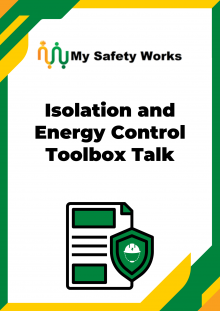
This isolation and energy control toolbox talk:
This isolation and energy control toolbox talk outlines some essential steps that should be considered and followed for the safe isolation and control of energy sources.
Isolation and energy control is a process to ensure that hazards and risks related to energised plant and equipment are assessed and managed to prevent an uncontrolled energy release.
The intent of this toolbox talk is to educate personnel and reduce the risk to any person who is required to clean, maintain, repair or adjust components that have energy applied under normal operating circumstances.
Isolation and energy control refers to specific procedures to prevent unexpected energisation or start-up of machinery or plant and equipment or the release of hazardous energy while employees are performing servicing or maintenance activities.
The purpose of isolation and energy control is to protect employees from injuries caused by the unexpected energisation or start-up of machinery or plant and equipment or the release of hazardous energy.
Isolation and energy control procedures require that machinery or plant and equipment to be shut down and de-energised before employees begin work on it.
Employees then place a lockout device on the energy-isolating device, which controls the energy source, to prevent the machinery or plant or equipment from being started.
Assess the energy types and determine the suitable safety methods for controlling the hazardous energy of the specific equipment.
The person authorising the work must notify all affected employees and other parties (e.g. management, supervision, operators and workers in the area) of:
If the equipment is operating, the person authorising the work must verify that it is safe to shut down. The equipment can then be stopped using the established methods and procedures for that item of equipment.
Isolation of energy sources should be completed by physically interrupting the supply of energy.
This can be achieved by following the lockout tagout program and control measures including:
After the energy sources are isolated, any stored energy in the equipment should be dissipated. This can be achieved by measures including:
If internal sources of energy cannot be dissipated, they must be adequately restrained by measures such as:
Each of the devices used to isolate, dissipate and restrain energy sources must be secured and identified in accordance with the risk management hierarchy of controls to prevent inadvertent energising or release of energy.

Securing isolation devices (lock-out) where practicable, the isolation device must be secured by a lock to provide assurance that:
The person authorising the work must ensure that competent persons verify that all hazardous energies have been effectively isolated, dissipated or restrained to prevent unexpected start-up, as per the isolation and control of energy procedure.
As each person completes their work on the equipment they must:
After confirming the completion of work, each person must remove their personal isolation locks and isolation tags.
Before removing the last isolation lock and tag, the person responsible for re-energising the equipment must ensure:
Note: Isolation and control of energy must only be carried out to the level of a person’s competence and authorisation.
This 3-page toolbox talk on isolation and control of energy outlines some essential steps that should be considered and followed for the safe isolation and control of energy sources.
